Fentanyl: Understanding the Drug and Fentanyl Withdrawal Timelines
Fentanyl is a powerful synthetic opioid that has caused widespread concern in recent years due to its potency and the severe consequences associated with its use. As one of the most potent opioids available, fentanyl has a significant impact on the body when abused. Fentanyl is most frequently encountered in various illicit forms, including pills, powders, or patches. The misuse of fentanyl can lead to severe health risks if handled carelessly or consumed inappropriately. Due to its exceptionally high potency, unsuspecting users can face life-threatening dangers, including overdoses with detrimental or even deadly side effects.
Seeking help for addiction requires courage and bravery. Whether you or a loved one is struggling with fentanyl misuse, it’s crucial to reach out for help quickly. Fentanyl addiction poses an immediate risk to your life. Hotel California by the Sea is dedicated to providing comfortable and compassionate care to meet each individual’s specific needs. Our comprehensive recovery programs encompass medically supervised detox, group and individual therapy, family counseling, partial hospitalization, outpatient services, aftercare, and supportive sober living environments. Your path to recovery starts with us.
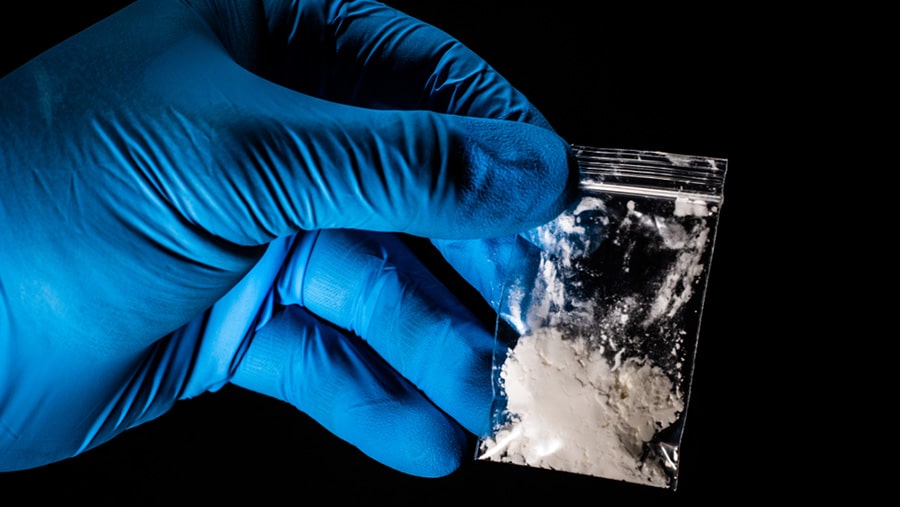
Fentanyl: An Overview
Fentanyl is a synthetic opioid originally developed for medical use as a painkiller and anesthetic. It is estimated to be 50 to 100 times more potent than morphine and approximately 50 times more potent than heroin.
When referring to Fentanyl, we won’t be primarily discussing medical grade Fentanyl. While abuse of medical grade Fentanyl does carry significant health risks, the Fentanyl Epidemic is largely referring to the use of illegally manufactured Fentanyl. This form of Fentanyl lacks any supervision in its manufacturing process, leading to significant variation in the strength and potency of the substance. As a result, users (regardless of how high their tolerance level to the drug is) are at a constant risk of overdose.
Fentanyl Withdrawal Timeline
Fentanyl withdrawal is a challenging and often painful process that occurs when individuals who have developed dependence on the drug attempt to stop using it. Fentanyl dependence comes on quickly. For the majority of users, they are unaware they are becoming physically addicted before it is too late to discontinue without symptoms. The severity and duration of withdrawal symptoms with fentanyl specifically are what drives users to continuously use the substance.
The actual fentanyl withdrawal timeline can vary depending on several factors, including the duration and dose of fentanyl use.
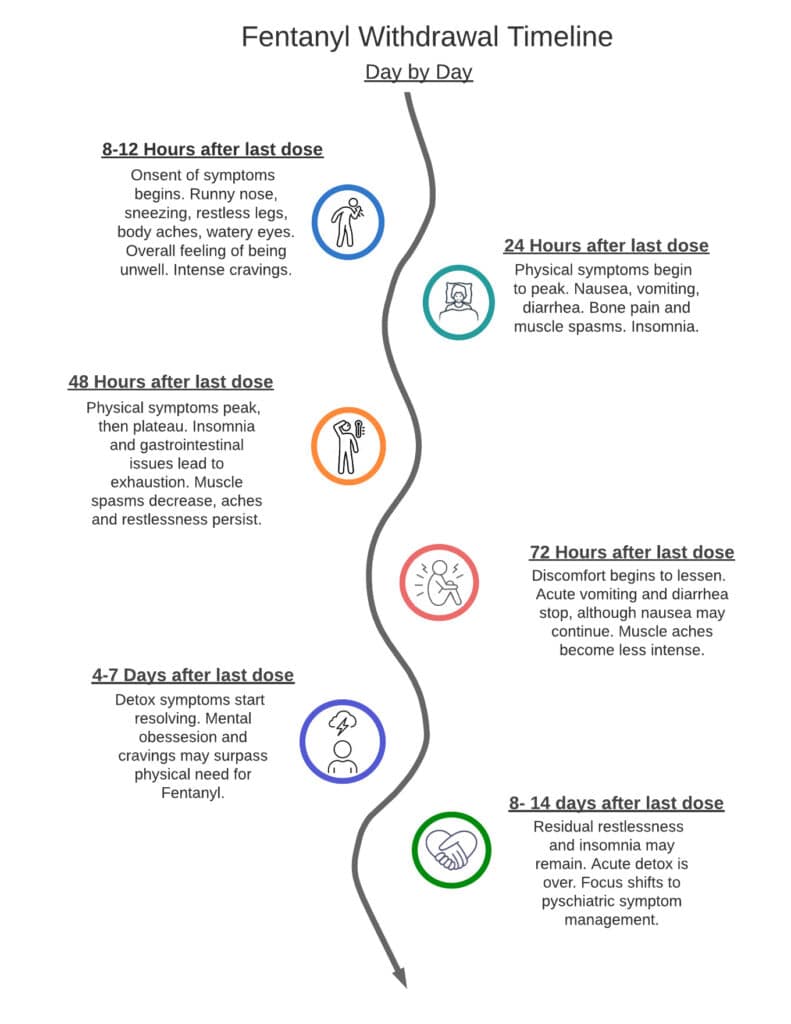
Withdrawal Symptoms in the first 24 hours
- Flu-like Symptoms: Fentanyl withdrawal often starts with flu-like symptoms, including muscle aches, sweating, chills, sneezing, and a runny nose.
- Gastrointestinal Distress: Individuals in withdrawal may experience nausea, vomiting, diarrhea, and abdominal cramping.
- Anxiety and Restlessness: Anxiety, restlessness, and irritability are common psychological symptoms during withdrawal.
- Insomnia: Sleep disturbances and insomnia can be significant challenges during fentanyl withdrawal.
- Joint and Muscle Pain: Musculoskeletal pain, often described as “bone pain,” can be intense. Restless legs and muscle spasms cause overall bodily discomfort.
- Psychological Symptoms: Depression, mood swings, and intense cravings for fentanyl are also common.
Duration of Withdrawal
The duration of fentanyl withdrawal can vary but typically follows a timeline:
- Early Withdrawal (First 24-72 Hours): During this phase, symptoms peak and are often the most intense. Individuals experience flu-like symptoms, muscle pain, and anxiety. This period of withdrawal is when addicts most commonly relapse. The discomfort of symptoms can be remedied by using, which makes it very tempting to resume abusing fentanyl.
- Acute Withdrawal (Days 3-5): As the acute phase progresses, gastrointestinal symptoms like diarrhea and nausea may become more pronounced. In some individuals, muscle spasms can occur. Psychological symptoms such as depression and cravings can also intensify. Insomnia may reach its peak, causing exhaustion and irritability.
- End Stages of Withdrawal (Days 6-14): Around this point, symptoms begin to lessen. Gastrointestinal issues are less intense, and sleeping may become more possible. Muscle spasms and restless legs improve, but aches and pains may still be present. While some lingering effects may still be felt, users are on their way to recovery.
Management of Withdrawal
Managing fentanyl withdrawal typically involves a combination of medical and psychological interventions. Medications are prescribed when appropriate to alleviate withdrawal symptoms and reduce cravings. Additionally, counseling and support groups play a crucial role in helping individuals cope with the psychological aspects of withdrawal and maintain long-term recovery.
The significant discomfort that happens along the fentanyl withdrawal timeline is a contributing factor as to why so many users have a hard time quitting. While not as long as some other detox processes, it can be very intense. However, with proper medical treatment, we are able to alleviate symptoms to a manageable level. Successful recovery from fentanyl addiction often requires a combination of medical treatment and psychological support, emphasizing the importance of comprehensive addiction treatment programs to address the complex nature of opioid addiction. Hotel California by the Sea offers daily individual doctor’s visits, along with 24/7 staff. We ensure a comfortable, nurturing environment in gorgeous locations to help make the transition from a life of painful addiction into a life of beautiful sobriety.
Fentanyl’s effects on the body
Pharmacological Properties
Fentanyl works by binding to the body’s opioid receptors in the brain, spinal cord, and gastrointestinal tract. This binding results in pain relief, sedation, and a sense of euphoria. Fentanyl’s potency is attributed to its ability to rapidly cross the blood-brain barrier, allowing it to reach the brain and central nervous system quickly. Users have an almost immediate response. Fentanyl can be snorted, smoked, or injected intravenously. Each route of administration carries its own risks. The primary concern with synthetic Fentanyl is because of the inconsistency of strength, no method of consumption is necessarily safer than the other in preventing overdose.
Therapeutic Effects
- Pain Relief: Fentanyl users may experience forms of chronic pain which lead to the use of narcotic pain relievers. As prescription pain medication was pulled from the shelves, some patients found themselves resorting to buying painkillers off the streets. Fentanyl is often the cheapest alternative when it comes to black market drugs. For those dependent on the substance not as a result of pain management, it is the only relief from the pain of withdrawal.
- Sedation: Fentanyl can induce sedation and relaxation, making it appealing to people searching for escape from their physical or mental troubles.
- Euphoria: Some users may experience a sense of euphoria.
Adverse Effects
- Respiratory Depression: One of the most significant dangers associated with fentanyl is respiratory depression. The sedative effect of fentanyl slows breathing and can stop breathing entirely when taken in too high of a dose. This, in combination with unconsciousness commonly associated with fentanyl abuse, results in death.
- Nausea and Vomiting: Fentanyl use can cause nausea and vomiting, leading to dehydration and drastic weight loss. Aspiration pneumonia is a serious illness that can be caused by vomit entering the lungs, which can happen when a fentanyl user vomits and then passes out.
- Tolerance and Dependence: Prolonged use of fentanyl can lead to the development of tolerance, requiring higher doses to achieve the same effects. Physical and psychological dependence develop quickly, leading to withdrawal symptoms upon discontinuation.
Check Your Insurance Coverage for FREE
Find out if your insurance covers addiction treatment in minutes. We accept most insurance!
Signs of fentanyl abuse
One of the ways to prevent a death from Fentanyl is to be able to spot family and friends in active addiction. With this knowledge, we are better able to offer resources to those struggling. Fentanyl users often attempt to hide their drug abuse. Common signs of fentanyl abuse are:
- Constricted (small) pupils- Often referred to as having “pinpoint pupils”, this is one of the most telltale signs of opiate abuse.
- “Nodding out”- Falling asleep at inappropriate times, or the inability to be fully conscious throughout day-to-day activities.
- Face itching and rubbing- Opioids cause itching, which can be body-wide but is most notable on the face.
- Gravely or scratchy voice- Respiratory depression lowers the tone in a user’s voice. This can also be caused by the post-nasal drip of snorting fentanyl, or damage to the lungs and throat by smoking fentanyl.
- Slow and Shallow breathing- This is caused by respiratory depression.
- Weight loss- Nausea from opioids may reduce appetite. Vomiting frequently can occur in some users. These combined result in significant weight loss.
- Gray or Sickly Appearance- Respiratory depression lowers blood pressure, which leads to slower blood circulation and “drained color” from the user’s skin, lips, and fingernails.
- Slurred speech- Excessive drowsiness impairs speech patterns.
Fentanyl Use Demographically
The stereotype of drug abuse is that it is contained to lower-income communities, or to individuals that have suffered traumatic events. Data is now actually reflecting that fentanyl abuse and death is widespread among people under 30 regardless of the demographic in which the user belongs to. Due to self-reports being unreliable in counting how many active Fentanyl users there are in any given state, the rate of Fentanyl use is measured by the death toll. These numbers give us insight into how severely fentanyl addiction is impacting our communities.
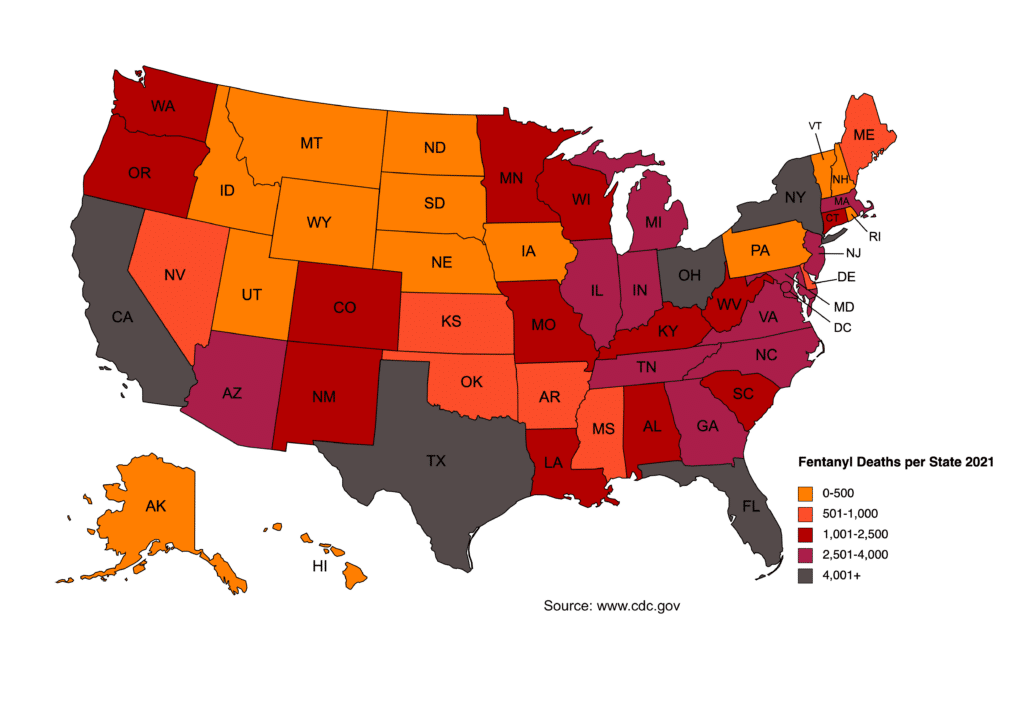
How is illicit fentanyl made?
The production of fentanyl requires the use of chemicals. These chemicals are referred to as “precursors”. For the vast majority of Fentanyl trafficked into the United States, these precursors are made in China. Precursors are primarily sent through international mail, as they are not technically a drug- they’re just an assortment of chemicals.
Laws have been put in place to stop specific blends of precursors from leaving the country. As a result, other countries like India are now supplying some of those precursors to Mexico. Mexico is the second stop for fentanyl production on the way to the United States.
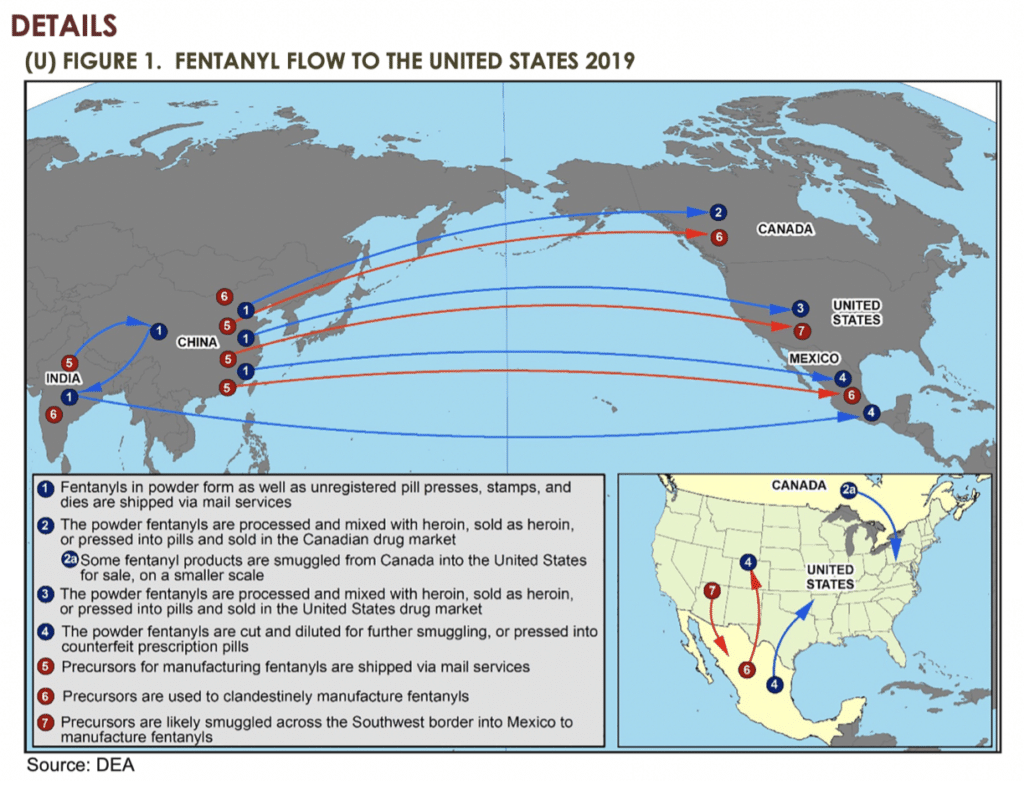
Once these precursors arrive in Mexico, they are used in large scale illicit factories to create synthesized fentanyl. This compound is pressed into pills or manufactured as a powder. It is then smuggled across the US-Mexico border in high amounts with low concentrations of fentanyl. Throughout this process, the only supervision in the actual making of fentanyl is the cartel ensuring their product doesn’t get seized by the authorities. There is no concern for the safety of the consumer or even those handling it. Because of this lack of oversight, the strength and quality of illicit fentanyl varies widely. While some batches may be weaker in strength, others have the power to kill in a single dose. This carelessness is costing thousands of lives in the ever increasing fentanyl epidemic.
The cost of the Fentanyl epidemic
Historically, there have been three major “waves” in opioid deaths. According to the CDC, 2013 marked the initial wave of synthetic opioid deaths. Fentanyl quickly rose to the primary culprit in opioid deaths.
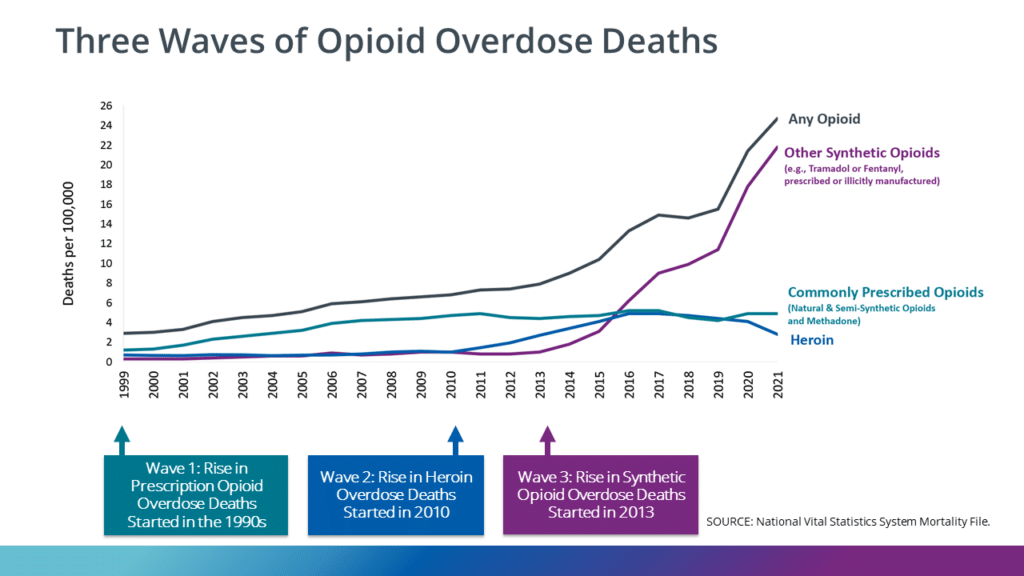
Fentanyl use has devastated communities nationwide. A minimum of 1,800 teenagers have died between the years 2019 and 2022 from fentanyl overdoses. This epidemic is not just affecting drug addicts on the streets or impoverished neighborhoods. It’s bleeding into every part of society. As state wide overdose deaths increase, residents of the states Washington, Ohio, and California are seeing the effects on their communities. In cities like San Francisco, California, open air drug markets flood the streets in which children frequent to get to after school programs. In Washington, there are reports of a one year old toddler being exposed to fentanyl smoke, who subsequently passed away. Ohio recently joined the top 10 states in fentanyl related deaths nationwide. These frightening statistics call for action nationwide.
Reach out to Hotel California by the Sea
We specialize in treating addiction and other co-occurring disorders, such as PTSD. Our Admissions specialists are available to walk you through the best options for treating your addiction.
Signs and Symptoms of Overdose
Recognizing the signs of a fentanyl overdose is crucial for fast intervention and potentially saving a life. It is important to remember that harm reduction/overdose intervention does not enable an addict. Instead, it keeps them alive and able to receive help. Common indicators of a fentanyl overdose include:
- Extreme drowsiness or unconsciousness
- Slow, shallow, or stopped breathing
- Restricted pupils
- Bluish or pale lips and fingernails
- Unresponsiveness to stimuli
If you suspect someone is overdosing on fentanyl, call 911 immediately and administer naloxone if available, as this medication can reverse the effects of opioid overdose. Many states offer Narcan at a reduced cost or even free to enable bystanders to carry it in case of emergency. Quick action can be life-saving in such critical situations.
What makes Hotel California by the Sea different for Fentanyl addiction treatment?
Here at Hotel California by the Sea, we take a holistic approach to recovery. We recognize that one size does not fit all, and work with you or your loved one on an individual basis. There is a broad range of therapy we offer, so that you and a licensed therapist can decide which path will be the most helpful for you. Some of our therapeutic methods include CBT, DBT, EMDR, Marriage and Family Counseling, and Group Therapy.
Our facilities are located in the scenic areas of Newport and Huntington Beach California, Bellevue Washington, and Cincinnati Ohio. Our comfortable, home-like environments equipped with 24/7 staffing and daily individual doctor’s visits ensure a safe and nurturing beginning to your recovery journey.
Conclusion
In the face of the alarming and deeply concerning fentanyl crisis, Hotel California by the Sea stands as a beacon of hope and support. We acknowledge the fear that this crisis evokes in individuals and communities alike. However, we want to emphasize that we are here to help. With our compassionate and experienced team, we are dedicated to providing the necessary care, guidance, and resources to those who need it most. Our commitment is unwavering, and together, we can navigate the challenges posed by the fentanyl crisis. We offer a path towards recovery, healing, and brighter tomorrows. You are not alone; we are here with you every step of the way.
References:
https://fox8.com/news/study-ohio-cracks-the-top-10-in-fentanyl-overdose-deaths/
